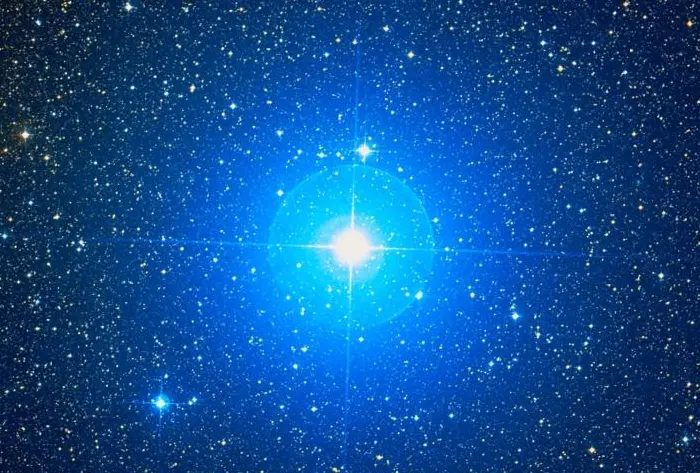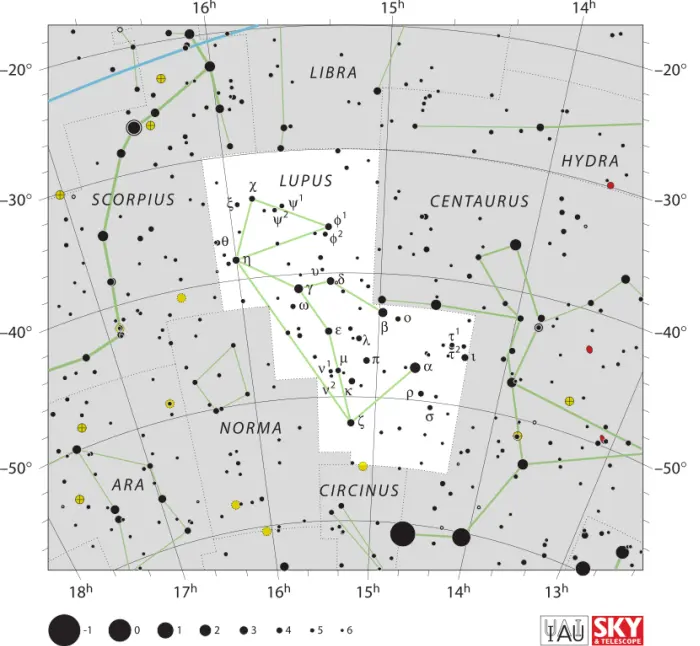Alpha Lupi (α Lup) is a hot blue giant located approximately 460 light-years away in the southern constellation Lupus (the Wolf). With an apparent magnitude of 2.30, it is the brightest star in Lupus. It is one of the closest supernova candidates to the solar system. In 2024, the International Astronomical Union (IAU) formally named the star Uridim.
Star type
Alpha Lupi is an evolved giant star of the spectral type B1.5 III. It has 10.1 times the Sun’s mass, which makes it a supernova candidate. It has expanded to a size of 7.46 solar radii as it evolved away from the main sequence. With a surface temperature of about 24,550 K, the blue giant is 18,200 times more luminous than the Sun. It spins at 9.5 km/s.
Even though it is still a young star, Alpha Lupi has already burned through its supply of hydrogen and evolved away from the main sequence. It only has several million years left before it suffers core collapse and goes out as a brilliant supernova. The star has an estimated age of only 16 – 20 million years.
Alpha Lupi is classified as a Beta Cephei variable. The giant star’s variability was first reported by a team led by the British astrophysicist Bernard Pagel in 1956.

Alpha Lupi, image: Wikisky (DSS2)
Beta Cephei stars (or Beta Canis Majoris variables) vary in brightness due to pulsations of their surfaces. They are typically massive, evolved stars that show small and rapid brightness variations over periods of several hours. Alpha Lupi has a variation period of 0.29585 days, and its brightness varies by around 0.05 magnitudes.
Other than the class prototypes Alfirk (Beta Cephei) and Mirzam (Beta Canis Majoris), bright stars in this class include Hadar (Beta Centauri) and Epsilon Centauri in the constellation Centaurus, Mimosa (Beta Crucis) and Imai (Delta Crucis) in Crux, Spica (Alpha Virginis) in Virgo, Shaula (Lambda Scorpii) and Girtab (Kappa Scorpii) in Scorpius, Beta Lupi in Lupus, Algenib (Gamma Pegasi) in Pegasus, Epsilon Persei in Perseus, and Alpha Muscae in Musca.
Facts
Alpha Lupi is one of the nearest supernova candidates to the Sun, along with IK Pegasi in the constellation Pegasus and Spica in Virgo. Like Alpha Lupi, Spica is a hot blue B-type giant classified as a Beta Cephei variable. It lies 250 light-years away, while the binary system IK Pegasi lies 154 light-years away.
Alpha Lupi is a member of the Upper Centaurus-Lupus subgroup of the Scorpius-Centaurus OB association. The Scorpius-Centaurus association is the nearest association of massive O- and B-type stars to the Sun. The members have an average age of 15 million years. These stars formed in the same stellar nursery at around the same time and share a common motion through space.
Other members of Upper Centaurus-Lupus subgroup include the hot blue giant Beta Lupi, the subgiants Gamma, Delta and Eta Lupi, the B-type main sequence stars Eta Centauri and Tau Librae, and the B-type subgiants Kappa Centauri and Pipirima (Mu2 Scorpii).
Alpha Lupi is on average the 78th brightest star in the sky. It is about as bright as Larawag (Epsilon Scorpii) in the constellation Scorpius and Epsilon Centauri in Centaurus.
Several double star catalogues list the 14th magnitude star 2MASS J14415376-4723331 as a companion to Alpha Lupi. The two stars are separated by 26 arcseconds in the sky. They are listed as WDS J14419-4723 in the Washington Double Star Catalog (WDS), CCDM J14419-4723 in the Catalog of Components of Double & Multiple stars (CCDM), and IDS 14353-4658 in the Index Catalogue of Visual Double Stars (IDS).
Name
Alpha Lupi has the proper name Uridim. The International Astronomical Union (IAU) named the star on September 12, 2024. The name is derived from the ancient Sumerian name for the constellation Lupus, UR.IDIM.
Until 2024, Alpha Lupi was one of the brightest stars without a formal name approved by the IAU, along with the brighter Gamma Velorum, Gamma Cassiopeiae, Gamma Centauri, and Epsilon Centauri.
Alpha Lupi was historically also called Kakkab. The name comes from ancient Mesopotamia. It is derived from the phrase Kakkab Su-gub Gud-Elim, meaning “the star left of the Horned Bull.” In Babylonian astronomy, the Horned Bull is a reference to the neighbouring constellation Centaurus.
In Chinese astronomy, Alpha Lupi was known as 騎官十 (Qí Guān shí), the Tenth Star of Imperial Guards. It formed the Imperial Guards asterism with Gamma Lupi, Delta Lupi, Kappa Centauri, Beta Lupi, Lambda Lupi, Epsilon Lupi, Mu Lupi, Pi Lupi, and Omicron Lupi. The asterism was part of the larger Root mansion, which represented the chest of the Azure Dragon.
In Star Names and Their Meaning, R. H. Allen gave Alpha Lupi the Chinese names Yang Mun and Men, “the South Gate.” However, the names are in error.
Location
Alpha Lupi lies in the region between the bright Antares in Scorpius and the stars of the Southern Cross. It is the brightest star between Epsilon Centauri and Antares. It appears along the imaginary line extended from Antares to Gacrux, the star at the top of the Southern Cross.
At declination -47° 23’, the giant star is visible from locations south of the latitude 42° N. However, it never rises very high above the horizon for observers in the mid-northern latitudes. It is best seen from the southern hemisphere.

The location of Alpha Lupi, image: Stellarium
Constellation
Alpha Lupi is located in the constellation Lupus. The celestial Wolf is one of the ancient Greek constellations, catalogued by Claudius Ptolemy of Alexandria in the 2nd century CE. It lies next to the brighter and larger Centaurus and was long considered an asterism within Centaurus.
The constellation is believed to be based on the Babylonian Mad Dog (UR.IDIM), a figure with a human head and torso and the legs and tail of a lion.
Lupus is not associated with any Greek myth in particular. It represents an animal chased by the Centaur. It was sometimes depicted as a wineskin held by Centaurus. The Greek astronomer Hipparchus of Bithynia separated the asterism from Centaurus in the 2nd century BC and named the constellation Therion, meaning “beast.”

Lupus constellation map by IAU and Sky & Telescope magazine (Roger Sinnott & Rick Fienberg) (CC BY 3.0)
Most bright stars in Lupus are hot blue members of the Scorpius-Centaurus association, including the B-type giant Beta Lupi and subgiants Gamma, Delta, Epsilon, Eta, and Iota Lupi. Most of these stars are supernova candidates.
Other notable stars in Lupus include the yellow giant Zeta Lupi, orange giant Phi1 Lupi, T Tauri star EX Lupi, and yellow dwarf Nu2 Lupi, which hosts three exoplanets.
Deep sky objects in Lupus include the planetary nebulae NGC 5882 and IC 4406 (the Retina Nebula), the supernova remnant SN 1006, the globular clusters NGC 5927, NGC 5824 and NGC 5986, and the open clusters NGC 5749 and NGC 5822.
The best time of the year to observe the stars and deep sky objects in Lupus is during the month of June, when the constellation appears higher above the horizon in the early evening. The entire constellation is visible from locations south of the latitude 35° N.
The 10 brightest stars in Lupus are Alpha Lupi (mag. 2.30), Beta Lupi (mag. 2.68), Gamma Lupi (mag. 2.77), Delta Lupi (mag. 3.20 – 3.24), Epsilon Lupi (mag. 3.41), Zeta Lupi (mag. 3.41), Eta Lupi (mag. 3.41), Iota Lupi (mag. 3.54), Phi1 Lupi (mag. 3.58), and Kappa1 Lupi (mag. 3.86).
Alpha Lupi
| Spectral class | B1.5 III |
| Variable type | Beta Cephei |
| U-B colour index | –0.88 |
| B-V colour index | –0.20 |
| Apparent magnitude | 2.30 (2.29 – 2.34) |
| Absolute magnitude | −4.3 |
| Distance | 460 ± 10 light-years (142 ± 3 parsecs) |
| Parallax | 7.02 ± 0.17 mas |
| Radial velocity | +5.40 ± 0.7 km/s |
| Proper motion | RA: −20.94 ± 0.14 mas/yr |
| Dec.: −23.67 ± 0.14 mas/yr | |
| Mass | 10.1 ± 1.0 M☉ |
| Radius | 7.46 ± 0.17 R☉ |
| Luminosity | 18,200 L☉ |
| Temperature | 24,550 K |
| Metallicity | 0.04 dex |
| Age | 16–20 million years |
| Rotational velocity | 9.5 km/s |
| Surface gravity | 3.46 cgs |
| Constellation | Lupus |
| Right ascension | 14h 41m 55.7557866s |
| Declination | –47° 23′ 17.515486″ |
| Names and designations | Uridim, Alpha Lupi, α Lupi, α Lup, HD 129056, HR 5469, HIP 71860, FK5 541, CD-46°9501, CPD-46 6927, SAO 225128, GC 19774, GCRV 8536, HGAM 2025, PPM 319805, EUVE J1441-47.3, IRAS 14385-4710, 2MASS J14415577-4723174, JP11 2524, 1RXS J144156.3-472332, SACS 316, UBV 12788, UBV M 20295, TYC 8283-4134-1, TD1 17625, Gaia DR3 5905821894507108864, CCDM J14419-4723A, IDS 14353-4658 A, WDS J14419-4723A |